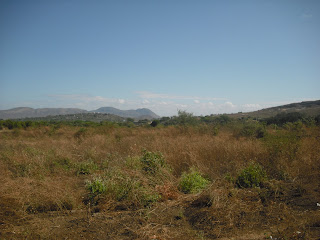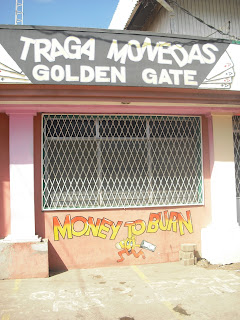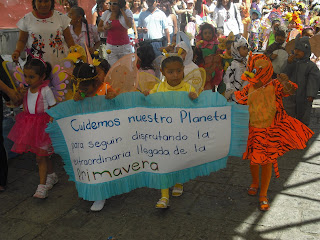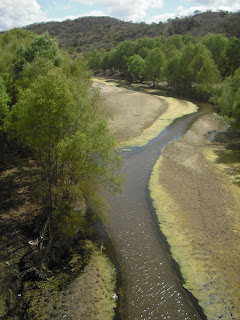Hi! Long time, no write. We had little or no internet for a while there and the few days we did have internet I wasn´t in the mood to write. The last week or so has been really intense so I´ll do my best to recount the most important bits. There will be some depressing information in this post because we were in areas that were very affected by the war.

These yellow flowering trees are pretty common and very striking. The only plant I can think of from home that is this yellow is a daffodil, but this is like 5,000 daffodils all bunched together.
.JPG)
We left Suchitoto last Thursday and headed east to the town of Ilobasco. On the way, we stopped in Cinquera at a bioreserve, which was a guerilla camp and hospital during the war. We took a beautiful hike with a guide and saw where the soldiers cooked (they had an oven like the ones used in Vietnam. The smoke is directed through a tube and exits far away from the camp so that if the army saw smoke and bombed the area, they would miss the camp) and there were still rough cots made of sticks from the hospital area. This tree is a ceiba. It has these spikes when it´s young but they come off once the tree is bigger.
.JPG)
This is part of the campus of Moje, a trade school for youth in Ilobasco who have dropped out of high school, or never made it there in the first place. They teach ceramics, woodworking and metalworks. They let us park on campus and camp out there.
.JPG)
This is in Perquin, in the state of Morazan. This area is very pro-FMLN, which is the political party made up of leftists, many of whom were guerilla fighters. These young people are painting a sign for the FMLN presidential candidate. The elections are on March 15th. According to a friend, the last elections were totally corrupt so the Arena candidate won. Some people have said that if that happens again, there will be a violent response from FMLN suporters. This country really doesn´t need more fighting so lets pray that doesn´t happen.
.JPG)
Near Perquin is the town of El Mozote, which was the site of the worst massacre in contemporary Latin American history, December 11th, 1981. This is a wall with some of the 1600 people who were killed by the El Salvadorean army, 450 of whom were children. The women, men and children were separated and killed, far enough from each other that they couldn´t see each other, but close enough that they could hear each other screaming. Only one woman, Rufina Amaya, survived. She was last in the line of women who were to be killed and she was able to sneak into the woods where she hid for 6 days until someone found her half-dead from starvation, dehydration and surely heartbreak. When her story reached the US, the Reagan administration denied it´s validity because they didn´t want to admit to having supported (we´re talking billions of dollars) a corrupt El Salvadorean Army. 10 years after the massacre, Argentinian archaeologists began excavation and quickly found hundreds of skeletons. Rufina Amaya died in her 70´s from a heart attack.
.JPG)
This is the mural in memory of the slain children of El Mozote.
.JPG)
Juan Franco is travelling with us now. He is an English teacher at Moje, in Ilobasco. He thought he would join us for a couple days, but is now planning on joining us as far as Managua, Nicaragua. It is really nice to travel with him--he is very sweet, thoughtful, faithful and easy to be with. I´m really glad he got to go to El Mozote with us because, though he is from El Salvador, he had never learned about the massacre. His family was very affected by the war. His family is Seventh Day Adventists, so they don´t go to war (the pacifist in me can appreciate that!). So, they were threatened by both sides and his father was almost killed three times. Each time his mother bought him back from the army or the guerillas. His mother was caught in crossfire three weeks after his older brother was born and still has shrapnel in her back. They had to leave their home town or be killed for not joining the war, so they left Chalatenango and now now live in Ilobasco.
.JPG)
Perquin is mountainous enough to have lots of pine trees, but still hot enough to grow bananas.

Me, Juan, Rosa, Karla, Iris. Karla is the 15 yr. old daughter of the family we stayed with in El Gigante, a small community about a kilometer from Perquin. The parents are Salvador and Reina and they also have a 7 yr. old son, Ali. El Gigante is a cooperative made up of people who all fought together with the guerillas. Salvador joined the guerillas when he was 11 years old because the army was killing boys his age if they didn´t join the army. He and Reina met and married during the war (she was a soldier too). Her whole family fled to Honduras because they were threatened with death by the army for living in guerilla controlled territory.
.JPG)
The fence at the entrance of a preserved guerilla camp next to the war museum in Perquin.
.JPG)
A 500 pound bomb dropped on this site, which created a crater the size of a house. The sign tells us that the bomb was made in the USA.
.JPG)
The view from the top of a hill in Perquin, looking north towards Honduras.
.JPG)
Reina and Ali at their home in El Gigante.
.JPG)
Salvador and Ali took us on a walk to see the land where he and Riena grow (organic) bananas, mango, cafe, oranges and several others. They also have more than 30 bee hives which produce excellent honey. We took a short cut through the forest to get back to the house because the sun was going down. It was absolutely gorgeous.
.JPG)
Salvador and Ali at a restaurant on our last night in Perquin. Ali got sick and Salvador was holding him so sweetly. It was wonderful to be with this family that so obviously love and care for each other. It turned out that Ali was really sick, so we cut dinner short and Rolene took him and his parents to the clinic. From there he was taken to the hospital in an ambulance. It was really scary because it seemed that he might be having a reoccurance of a blood infection he had several months ago, but we just called them today and found out it was a parasite and he´s back at home with medicine.
Whew, that was a lot of picture-loading and story-telling.
We are now in Marcala, Honduras. We had a really scary time getting here over a really terrible mountain pass (this is the worst road I have ever seen--huge holes, rocks, dips). When we got to the Honduras border, Rolene lost control of the truck and slid backwards a little and went into a ditch. She got out of the truck to look at whether the wheels were touching the ground. When she was out of the car (Juan and I were in the back) it began sliding backwards again and the open drivers door knocked her down, crunching her legs between the door and a big cement block. Then she went all the way down and we rushed out of the camper to help her. She was screaming, ¨Get me out!!!¨ When we got around to the drivers side, we saw that her legs were trapped under the front wheel. Juan and I pushed as hard as we could and moved the truck just enough so that Rolene could slide her legs out and then we couldn´t hold it any more. We let go and the truck slid back another 10 feet before crashing into the mountain wall. The miracles are threefold. 1)As Rolene was going down, she had the sense to turn the wheel to the left so the truck would hit the mountain instead of going over the side of the cliff, possibly saving Juan´s and my life and certainly saving the truck. 2) Somehow Juan and I were able to push a 6,000 pound truck uphill far enough that Rolene could escape. 3) Rolene is bruised and sore, but she has her legs and her life. If I didn´t believe in divine intervention before, I do now.
We´re taking it very easy while Rolene heals. Today we are headed to a El Tigre National Park near the capital. A few other things were amazing about the accident and the past couple days since then. 11 people, some border agents and some people just passing by, dropped everything to help us. Also, while our accident was happening, a bus pulled into the border area and broke down. A couple got off and asked us for a ride. We didn´t want to at first because we just wanted to get to Marcala (a couple hours away on the terrible road) and take care of Rolene, but we decided to help them out. Then we stopped for 4 more people and two of them happened to be Carol and Kent, New Zealanders we met back in Suchitoto. So, we had 9 people and all their stuff in the truck. It was really great to be able to help other people after our traumatic event. It took our minds off of what happened and gave us good company and extra support. Kent fixed the driver´s side mirror and is working on the door, which got pretty bent and Carol gave Rolene some healing medicines and did some body work on her. They are coming with us to the National Park, which we are very glad about.
Well, if you´ve gotten this far I applaud you. Send Rolene healing energy and keep us in your thoughts and prayers.

.JPG)
.JPG)
.JPG)
.JPG) This is Jeanette McDermott. She's traveling with us for a couple weeks and filming a movie about Walk With Earth! She's a journalist with a long history of environmental and social justice work and is a generally wonderful person. We laugh a lot and have great conversations about justice issues and spirituality. I'll let you know when the film is posted to YouTube.
This is Jeanette McDermott. She's traveling with us for a couple weeks and filming a movie about Walk With Earth! She's a journalist with a long history of environmental and social justice work and is a generally wonderful person. We laugh a lot and have great conversations about justice issues and spirituality. I'll let you know when the film is posted to YouTube..JPG)
.JPG) This is the group of us who went with a guide to the bat caves at Volcan Masaya. I've been to more impressive caves, and seen more bats at one time before. However, I've never been this close to bats (the pics are too dark to be very cool) and we went down into the caves with flashlights. When we got deep into the cave we all turned off our lights and sat in the pitch dark. It was so dark, there was no difference when my eyes were opened or closed. We learned that where we were sitting was where the indigenous people of long ago had an altar and celebrations after offering sacrifices (animals, virgin women, children) to the volcano gods. Kinda spooky, but mostly just really really dark.
This is the group of us who went with a guide to the bat caves at Volcan Masaya. I've been to more impressive caves, and seen more bats at one time before. However, I've never been this close to bats (the pics are too dark to be very cool) and we went down into the caves with flashlights. When we got deep into the cave we all turned off our lights and sat in the pitch dark. It was so dark, there was no difference when my eyes were opened or closed. We learned that where we were sitting was where the indigenous people of long ago had an altar and celebrations after offering sacrifices (animals, virgin women, children) to the volcano gods. Kinda spooky, but mostly just really really dark. .JPG) Cemetery near Granada.
Cemetery near Granada. .JPG) This is the street that leads into the market area of Granada. Imagine, a few blocks away is and area with beautiful buildings, cobblestone streets and lots of tourists paying lots of money for lots of things. Strange, to say the least.
This is the street that leads into the market area of Granada. Imagine, a few blocks away is and area with beautiful buildings, cobblestone streets and lots of tourists paying lots of money for lots of things. Strange, to say the least. .JPG) On the walk somewhere near Masaya, the town near the volcano. I have a love/hate relationship with the buses. Mostly love because they are frequent, cheap, fast, and interesting. The assistant hangs out of the door to ask people if they are getting on with a flip of his hand while yelling the final destination of the bus. I can't think of anything I hate about the buses right now. Maybe I only have a love relationship with them.
On the walk somewhere near Masaya, the town near the volcano. I have a love/hate relationship with the buses. Mostly love because they are frequent, cheap, fast, and interesting. The assistant hangs out of the door to ask people if they are getting on with a flip of his hand while yelling the final destination of the bus. I can't think of anything I hate about the buses right now. Maybe I only have a love relationship with them. 





















.JPG)
.JPG)
.JPG)
.JPG)
.JPG)
.JPG)
.JPG)
.JPG)
.JPG)

.JPG)
.JPG)
.JPG)
.JPG)
.JPG)
.JPG)
.JPG)

.JPG)
.JPG)
.JPG)
.JPG)
.JPG)
.JPG)